(G6)Unit1电子教案
- 格式:doc
- 大小:46.00 KB
- 文档页数:3
![人教版选修六Unit1教案新部编本[1]](https://uimg.taocdn.com/a0f0b364af45b307e87197db.webp)
教师学科教案[ 20 – 20 学年度第__学期]任教学科:_____________任教年级:_____________任教老师:_____________xx市实验学校高二年级英语备课组集体教案Module 6Unit 1 Art组长李新钊组员师朝关余继光张雪芹张彩凤王晶李森陈茜I.单元教学目标:1.Talk about art and galleries2.Talk about likes and preferences3.Learn words in families4.Use the subjunctive mood5.Writer a letter to give suggestionII.目标语言1.功能句式。
Talk about likes and preference:I’d prefer…/ I’d rather…/ I’d like…/ which would you prefer…./ I really prefer…/ would you rather…/ would you like…or…2.词汇abstract, sculpture, gallery, consequently, belief, consequent, convince, shadow, ridiculous, controversial, nowadays, attempt, predict, aggressive , scholar…3.语法: the subjunctive moodif I were you…./ I wish I could…4.重点句子1.There are so many different styles of western art it would be impossible to describe all of them in a short text.2.People became focused more on human and less on religion.3.If the rules of perspective had not been discovered, people would not have been able to paint such realistic pictures.4.At the time they were created, the impressionists’ painting were controversial but today they are accepted as the beginning of what we now call “modern art”.5.It is amazing that so many great works of art from late-19th century to 21st century could be contained in the same museum.III.教材分析。
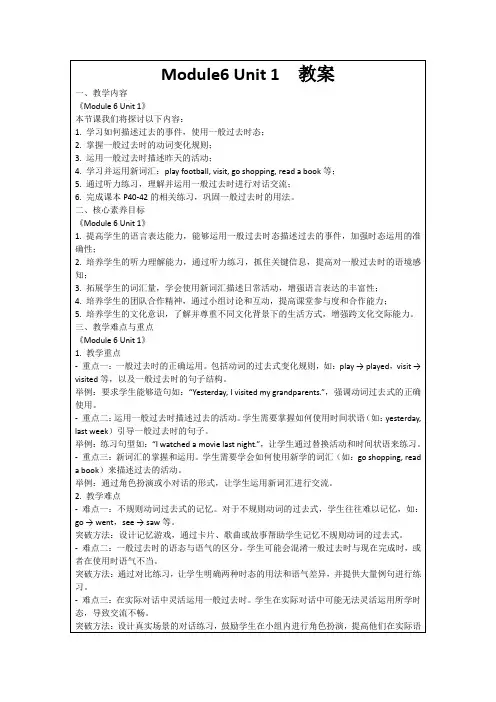
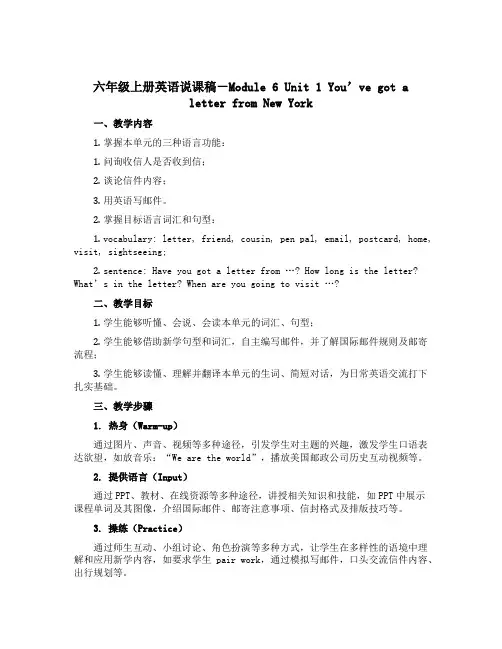
六年级上册英语说课稿-Module 6 Unit 1 You’ve got aletter from New York一、教学内容1.掌握本单元的三种语言功能:1.问询收信人是否收到信;2.谈论信件内容;3.用英语写邮件。
2.掌握目标语言词汇和句型:1.vocabulary: letter, friend, cousin, pen pal, email, postcard, home, visit, sightseeing;2.sentence: Have you got a letter from …? How long is the letter? What’s in the letter? When are you going to visit …?二、教学目标1.学生能够听懂、会说、会读本单元的词汇、句型;2.学生能够借助新学句型和词汇,自主编写邮件,并了解国际邮件规则及邮寄流程;3.学生能够读懂、理解并翻译本单元的生词、简短对话,为日常英语交流打下扎实基础。
三、教学步骤1. 热身(Warm-up)通过图片、声音、视频等多种途径,引发学生对主题的兴趣,激发学生口语表达欲望,如放音乐:“We are the world”,播放美国邮政公司历史互动视频等。
2. 提供语言(Input)通过PPT、教材、在线资源等多种途径,讲授相关知识和技能,如PPT中展示课程单词及其图像,介绍国际邮件、邮寄注意事项、信封格式及排版技巧等。
3. 操练(Practice)通过师生互动、小组讨论、角色扮演等多种方式,让学生在多样性的语境中理解和应用新学内容,如要求学生pair work,通过模拟写邮件,口头交流信件内容、出行规划等。
4. 巩固(Consolidate)通过练习册、作业布置、小结回顾等方式,帮助学生夯实知识点、掌握语言技能、巩固语言习惯,如老师布置以“Write an email to your classmates about your recent holiday plans”为题的作业。
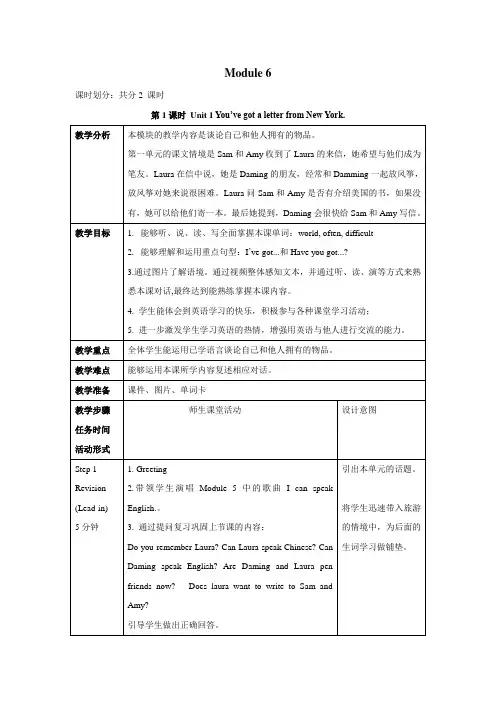
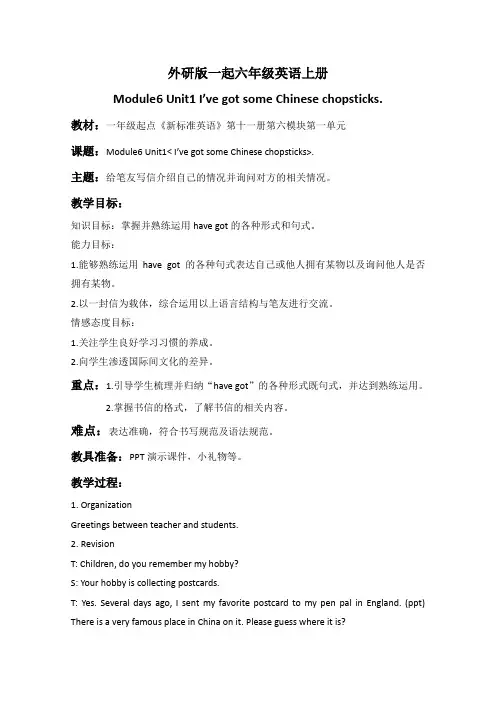
外研版一起六年级英语上册Module6 Unit1 I’ve got some Chinese chopsticks.教材:一年级起点《新标准英语》第十一册第六模块第一单元课题:Module6 Unit1< I’ve got some Chinese chopsticks>.主题:给笔友写信介绍自己的情况并询问对方的相关情况。
教学目标:知识目标:掌握并熟练运用have got的各种形式和句式。
能力目标:1.能够熟练运用have got 的各种句式表达自己或他人拥有某物以及询问他人是否拥有某物。
2.以一封信为载体,综合运用以上语言结构与笔友进行交流。
情感态度目标:1.关注学生良好学习习惯的养成。
2.向学生渗透国际间文化的差异。
重点:1.引导学生梳理并归纳“have got”的各种形式既句式,并达到熟练运用。
2.掌握书信的格式,了解书信的相关内容。
难点:表达准确,符合书写规范及语法规范。
教具准备:PPT演示课件,小礼物等。
教学过程:1. OrganizationGreetings between teacher and students.2. RevisionT: Children, do you remember my hobby?S: Your hobby is collecting postcards.T: Yes. Several days ago, I sent my favorite postcard to my pen pal in England. (ppt) There is a very famous place in China on it. Please guess where it is?S: Is it the Great Wall\ the Summer palace\ the Ming Tombs….T: ( ppt) Look , It’s the Great Wall. Can you tell us about the Great Wall?S: It’s long. It’s ten thousand li long. And it’s very old. It’s more than two thousand years old.T: Good. And yesterday , I received a postcard from my pen pal. Also there is a place on it, please guess.(Let students say something about Chinatown as the Great Wall.)【教师将本学期第一、二模块的内容有机的整合到这节课当中,使前面学过的知识在后面的学习过程中有反复呈现的机会和过程,有利于学生复习和记忆】T: My pen pal sent me a letter, too. But something happe ned with my letter, I can’t see it clearly. Please help me complete the letter.【通过一封来自英国的信,学生即复习了各类型的知识点,如:介词,单复数,时态等,又交代了本课的任务——给笔友写一封信,而且巧妙地引出了下一个送礼物的活动,一举三得。
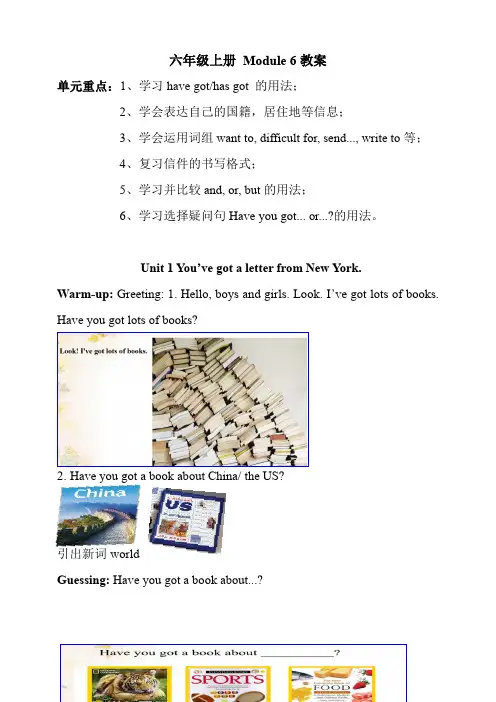
六年级上册Module 6教案单元重点:1、学习have got/has got 的用法;2、学会表达自己的国籍,居住地等信息;3、学会运用词组want to, difficult for, send..., write to等;4、复习信件的书写格式;5、学习并比较and, or, but的用法;6、学习选择疑问句Have you got... or...?的用法。
Unit 1 You’ve got a letter from New York.Warm-up: Greeting: 1. Hello, boys and girls. Look. I’ve got lots of books. Have you got lots of books?2.Have you got a book about China/ the US?引出新词worldGuessing: Have you got a book about...?Activity 1: What books has John got? (播放活动1部分的视频)Activity 2: Look. Sam and Amy have got a letter. It’s from New York. It’s from .... 提出问题,让学生思考并视听活动2部分的视频内容。
It’s a letter from Laura. Please say something about Laura. 让学生再读信件第一段,并找出Laura的相关信息。
Laura is Daming’s friend. She lives in New York. She’s from London. She’s British. 引出British的学习。
读信件第二段,回答问题:小结:读二、三段,并整理信息Retell the text: 将一些单词替换成图片,降低学生复述的难度。
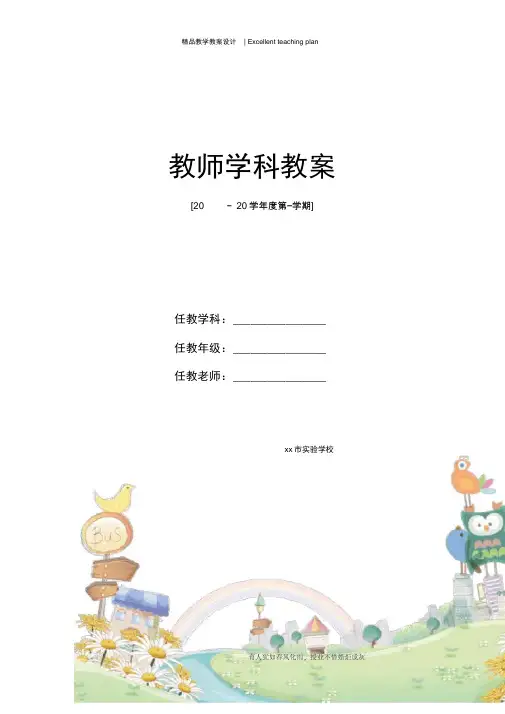
教师学科教案[20 - 20学年度第—学期]任教学科:________________ 任教年级:________________ 任教老师:________________xx市实验学校Module 6Unit 1 Can I have some sweets?一.学习目标:知识目标:1. 听读并理解生词soup,sweets,bread,biscuits,fruit,dark,turn on,light 在课文中的运用。
2. 能够使用Can I have some… 这类语句。
3. 听懂会读并理解课文。
能力目标:能够听、说、认读单词,能够用本课的功能用语和他人交流。
情感目标:培养学生学习英语的兴趣,激励学生积极参与活动,积极与他人合作。
学习重难点:掌握语言结构Can I have some ...?极其回答Yes, you can./Sorry, you can '能听、说、读单词,并能熟练运用新知识与他人对话。
二、预习学案:我会写(将下列字母组合成正确的单词)。
wsetse derbaibicuts posu三、导学案:热身复习:1、Greeting2、教师先把全班学生分成两大组,规定回答问题对者得贴画,贴画多的那个小组获胜。
培养竞争意识。
教师展示图片,一名同学扮演老师大声问:Can you do morning exercises/swim/jump/run/wash clothe?s 小组回答:Yes,I can./No, I can通过此活动复习Can you…?自主学习:1、听录音两遍,边听边圈出生词,并试着读一读。
2、播放录音,回答问题:Who is on birthday?How old is Amy ?Can Amy have some food at first?Can Amy have some food at last?3、找出课文中含有单词can 的问句,并写下来。
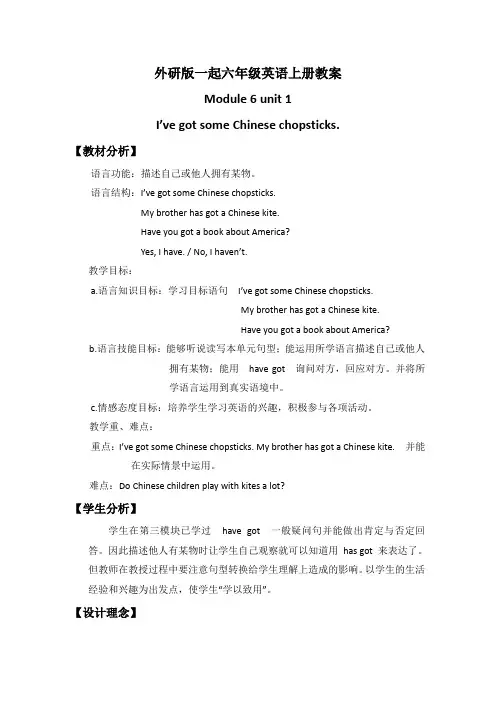
外研版一起六年级英语上册教案Module 6 unit 1I’ve got some Chinese chopsticks.【教材分析】语言功能:描述自己或他人拥有某物。
语言结构:I’ve got some Chinese chopsticks.My brother has got a Chinese kite.Have you got a book about America?Yes, I have. / No, I haven’t.教学目标:a.语言知识目标:学习目标语句I’ve got some Chinese chopsticks.My brother has got a Chinese kite.Have you got a book about America?b.语言技能目标:能够听说读写本单元句型;能运用所学语言描述自己或他人拥有某物;能用have got 询问对方,回应对方。
并将所学语言运用到真实语境中。
c.情感态度目标:培养学生学习英语的兴趣,积极参与各项活动。
教学重、难点:重点:I’ve got some Chinese chopsticks. My brother has got a Chinese kite. 并能在实际情景中运用。
难点:Do Chinese children play with kites a lot?【学生分析】学生在第三模块已学过have got 一般疑问句并能做出肯定与否定回答。
因此描述他人有某物时让学生自己观察就可以知道用has got 来表达了。
但教师在教授过程中要注意句型转换给学生理解上造成的影响。
以学生的生活经验和兴趣为出发点,使学生“学以致用”。
【设计理念】教师要依据“学生能用英语做什么”的思想设计教学活动,计划采用“任务型”教学方式,让学生就本课所学句型:I’ve got some Chinese chopsticks.My brother has got a Chinese kite. 达到用英语完成各种真实的生活、学习等任务。

Module 1 Unit 1 You and me一、Ⅰ.教学目标:1. 能够听、说、读、写单词:weight, kilogram, centimetre, fan, theatre;能够用句型“How tall are you? I’m…centimetres tall.”“How much do you weigh? I weigh …kilograms. ”来描述自己和他人的身高、体重,并进行问答;能够用一般现在时描述一个人的爱好。
2. 在思考、调查、讨论、交流、合作和问答等师生互动活动中,能够正确对人的年龄、身高、体重进行问答;熟练使用一般现在时描述自己的爱好。
3. 培养学生在实际生活情境中运用目标语言交流的热情和能力,保持英语学习的积极态度和信心。
Ⅱ. 能力目标:(1)培养学生的语言运用能力和自主探究能力。
(2)培养学生获取信息、处理信息的能力。
Ⅲ. 情感、策略目标(1)情感目标:培养学生热爱同学,互帮互助的的情感。
(2)策略目标:培养学生自主合作学习的能力。
二、教学重、难点1、重点:掌握对个人信息咨询的句子。
2、难点:询问身高体重以及回答的句型在实际生活中的运用。
三、课前准备1.课件和相关词卡2.学生当堂练习题Step1. Preparation1. Greetings between T and SsT: Now class begins .Hello, boys and girls .Ss: Hi, Miss Wang .T: How are you ?Ss: I’m fine, thank you..T:I’m fine too.(设计意图:通过师生交流,引出部分话题)2. Sing a song(设计意图:通过唱歌调节课堂气氛,拉近师生之间的距离,让学生在轻松愉快的环境中进入英语学习世界)3. Free talkshow a picture of Yao Ming and let the students guess his weight and height.Step2.Presentation( words , grammar and usage)(一)单词训练(1)板书句型How old… are/ … ?I’m … .T: I’m 28 years old .How old are you, boys and girls ? 师问生S1(师边说边板书句型How old are you ? )S1:I’m 12 years old .(2)板书How tall are you? I’m…centimeters tall.T: I’m 160 centimetres tall . How tall are you ?师问S2S2:I’m 150 centimetres tall .(3)板书How much do you weigh? I weigh…kilograms.T: I weigh 46 kilograms .How much do you weigh?师问S3S3: I weigh 35 kilograms .(4)板书What do you usually do after school? I usually …T: I usually play table tennis after school.What do you usually do after school?师问S4I usually play football after school.(师边做动作边说)(二)词句链接(1)课件展示展示两张对比明显的照片,让学生进行比较。
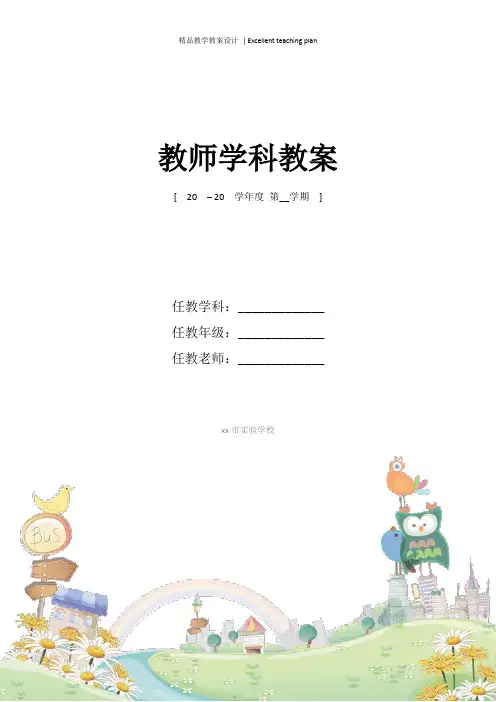
教师学科教案[ 20 – 20 学年度第__学期]任教学科:_____________任教年级:_____________任教老师:_____________xx市实验学校Module6Unit1 I bought you this book.learning aims:(1)能听懂、会说、会认、会读baseball , team , playing baseball , give it to you , baseballteam , looks interesting 等单词与短语。
(2)能听懂会说:1) I bought you this book.2) It looks interesting.3) Who gave it to you?4) Simon’s family gave it to me.等句子。
(3)掌握动词过去时的几种不同构成形式,并会使用.Step 1. Warm-up and show the learning aims.1.全体学生起立,一起跟随音乐复习上一单元的poem(课本21页,activity 3)。
随着音乐,大家一起说唱。
边唱边做动作。
2. T: Boys and girls, today we are going to learn Module 6 Unit1 I bought you this book. (板书课题) First, please look at our learning aims.(出示本课学习目标,教师慢慢读,学生仔细看、认真听。
)Step2 : Show the guides (指导自学)1、Read the new words by oneself in 3 minutes.2、 Find the words “bought, gave” in the dialogue. Under line the sentences with “bought, gave”.3、Play the tape. Listen and read the text。
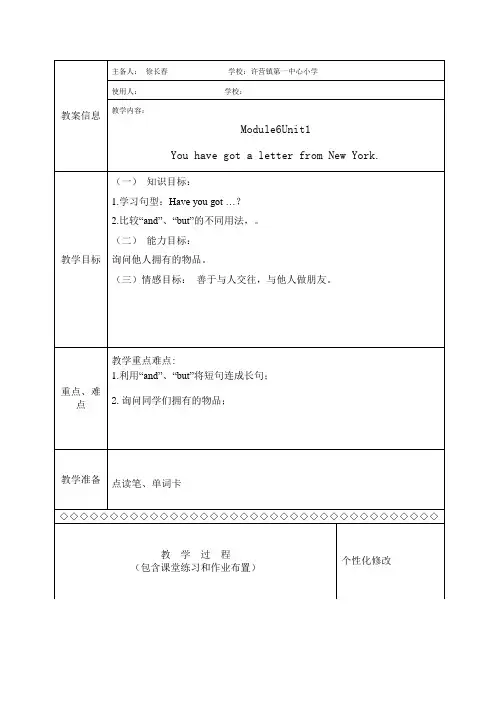
Module6 Unit1 第1课时教案一、教学内容外研版小学英语六年级上册第六模块第一单元第一课时:Unit 1 1. Look, listen and say. 2. Listen and read.二、教学目标1. 大多数学生能够听、说、读、写单词或短语:world,difficult,often,about,get a letter from。
2. 大多数学生能够听懂并用句型“Have you got...? I have got...”讲述个人所拥有的物品,通过描述不同国家的人们使用的物品进行文化对比,复习“have/has got”的用法。
3. 能够运用所学的语言知识与同伴进行交流。
三、教学重难点重点:1. 听说读写单词和短语:world,difficult,often,about,get a letter from。
2 复习句型:Have you got…? I have go ...难点:1. 用句型“Have you got…?I have got..讲述个人所拥有的物品。
2. have/has got 的用法。
3. 如何用英语给笔友写信,格式如何!四、教学准备1.单词卡片。
2.同步课文动画。
3.第1课时教学课件。
4.人物萨姆和约翰的头饰五、教学设计Step 1 Warm-up1. Have a dictation of the new words and new sentences of Module 5.2. Use the PPT to show the song of Page 30, let the students sing the song together, clap their hands at the same time.设计思路:通过听写复习上一模块的单词和句型,通过一首英文歌曲激发学生的学习积极性,拉近师生间的距离。
让学生快速地进入学习状态。
使教学环节自然过渡到下一环节。
Unit 6一、教材分析故事以太空为话题,呈现了更多的太空天体以及有关人类天空探索的内容,其中也包括我国航天事业发展情况,渗透了爱国主义教育内容。
整个故事以Mocky等人参观博物馆的过程展开,在前一部分呈现了一些行星的介绍,后一部分介绍了人类探索宇宙的历史,包括登月以及我国航天员的介绍。
故事中复习、复现了日期、做比较等内容,以复习为主。
二、教学内容、配图故事:参观博物馆话题:自然与宇宙句型:复习本学期主要表达法三、教学目标在本课结束时,学生能:1、在插图和对话的帮助下,读懂故事叙述文本的内容;2、在插图的提示下,讲述故事主要内容;3、了解我国航天英雄的事迹,增强民族自豪感和自信心。
四、教学重难点重点:阅读叙述文本,理解故事大意。
五、教学过程一、Warm up:师生问答。
问学生周末他们的活动,去了哪里、做了什么(结合学生实际,复习过去式用法)二、Learn the story(一)1、呈现图1,学生猜Mocky等人去了哪里。
2、呈现博物馆的照片,问学生周末是否去过博物馆。
3、开展头脑风暴活动。
采用问答方式,让学生猜Mocky等人在博物馆看了什么展览。
(结合插图引入话题,预测故事内容。
)(二)1、学生独立看连环画故事。
2、提问Mocky在博物馆参观了什么展览,看到了什么。
注意使用过去时态问答。
T:What did Mocky see in the museum?Did he see some planets/astronauts?3、呈现图1-5,采用问答方式,学生看对话内容,教师根据叙述文本讲述故事内容。
把Mocky看到的星体、行星贴在黑板上。
4、呈现图6-9,问学生是否知道照片中的宇航员是谁,然后根据叙述文本的内容介绍人类登月的历史。
把宇航员的图片贴在黑板上。
让学生看图10-11,说一说杨利伟和刘洋的太空飞行,例如日期和主要经过等。
(构建故事主要内容,渗透爱国主义情感教育。
)(三)1、学生朗读人物对话,教师讲述故事,双方配合表演完整的故事,2、让学生根据黑板上图示的内容,试着讲一讲故事。
Module6 Unit1 参考教案一、教学内容外语教学与研究出版社(一起点)六年级上册第六模块Unit 1 I’ve got some Chinese chopsticks.二、教学过程建议(一)热身导入1. 请学生演唱SB Module 5 Unit 2活动4的歌曲,鼓励学生边唱边做动作。
2. 播放SB Unit 1活动1的动画或录音,请学生看动画或边听录音边看挂图,引导学生理解语境:Sam问一位外国学生有没有关于中国的书,这位学生说没有。
Sam继续问他有没有关于美国的书,他也说没有。
Sam问他有什么书,他说他有一本关于世界的书。
3. 再次播放录音,请学生看图跟读,并学习“world”的语义。
4. 请学生两人一组朗读对话,然后请部分学生展示。
(二)任务呈现教师对学生说:“同学们,为了拓宽大家的阅读面,我们班要扩大图书角的规模(如果班级原来没有图书角,则说要建立班级的图书角)。
因此,请各位同学提供图书,与其他同学一起分享。
这节课先请大家介绍自己拥有什么种类的书,下节课再请大家提供可以用于交换阅读的书,好不好?在这之前,我们还是先来学习课文,看一看如何用英语表达‘拥有’某物。
”(三)课文学习1. 播放SB Unit 1活动2的动画或录音,请学生看动画或边听录音边看挂图。
教师帮助学生理解课文语境。
2. 再次播放录音,请学生完整听一遍课文,进一步理解语句。
播放第三遍录音,请学生逐句跟读。
对于学生跟读有困难的语句,教师先带读较难词语,然后按照意群、节奏重点带读,请学生注意模仿语音语调。
3. 在跟读过程中,通过展示图片、做动作、说明等方式,学习“difficult, answer”的语义,并进行运用训练。
4. 请学生观察、分析、归纳对话中“have/has got...”的特点及基本用法,并训练“have/has got...”与不同人称的搭配使用。
5. 教师请学生说一说对话中连接语句的连词“but”和“and”的语义,并请学生观察、分析、归纳“but”和“and”的特点及基本用法。
教师学科教案[ 20 – 20 学年度第__学期]任教学科:_____________任教年级:_____________任教老师:_____________xx市实验学校Module 6 Animals in danger【教材分析】本模块以“Animals in danger”为话题,以学习动词不定式的用法为主线,介绍了当前濒临灭绝,需要人类保护的动物的情况, 并重点介绍了大熊猫的保护情况。
在此基础上,学生可以根据自己的建议制定更合理的动物保护措施。
Unit 1 It allows people to get closer to them.【教学目标】●Knowledge objectiveTo master the useful words and sentences.Words: snake, thin, danger, interested, allows, wild, protect, grow, enough, dirty, peace, earth, raiseExpressions: in danger, at last, be interested in, think of, take away, in peace, on earth, in order to, look after●Ability objective1. To help students to improve their ability of listening and speaking.2. Enable students to understand conversations about animals in danger.●Moral objective1. To help students know the importance of protecting animals and our environment.2. Improve their sense of duty to love and protect animals.【教学重点】New words and expressions.To learn the grammar knowledge of infinitive.【教学难点】Cultivating the ability of expressing opinions.【教学方法】PWP method, task-based method and interactive approach【教学手段】A tape recorder, multimedia and some pictures【教学过程】Teaching Procedures:Step 1 Lead-inSs look the pictures and guess what the animal is.Step 2 Consolidate new wordsLook and say. The teachers shows the pictures of new words and let the students to say the new words as quickly as possible.Step 3 Say the meaning of the phrases.Work in pairs. Let Ss say the meaning of the phrases as quickly as possible.Step 4 ListeningListen and answer the questions.1. What’s this week’s Animal World about?2. Which animals are in danger?Step 5 Listen to Activity 3 and answer the following questions.1. Is Betty more interested in Wolong Panda Reserve?2. Do many animals have a safe place to live?Step 6 Find out the sentence of infinitive.Work in pairs. Let Ss find out the sentences of infinitive as many as possible. Give the prize to the first group.Step 7 Read Activity 3 and answer the questions.1. Did Betty see the pandas at the zoo?2. Is Betty interested in the pandas?3. What does Lingling think of the pandas and other animals in danger?4. Why do many animals not have a safe place to live?Step 8 Now complete the table.Step 9 Complete the passage with the correct form of the words and expressions in the box.Let Ss read the passage first and choose the words and expressions from the box. Step 10 Everyday English…at least!Help!What can we do?Step 11 Language points1. But I am more interested to see the pandas in the Wolong Panda Reserve.be interested to do sth. 对做……感兴趣be interested in sth. 对……感兴趣be more interested in 对……更感兴趣e.g. The boy is interested in the film.2. …because it allows people to get closer to them.to get closer to them在句中作宾语补足语,类似的结构有很多,例如:ask sb. to do sth. 请求某人做某事need sb. to do sth. 需要某人做某事want sb. to do sth. 想要某人做某事allow sb. to do sth. 允许某人去做某事e.g. His father doesn’t allow him to play before finishing his homework.3. It’s sad to think of pandas and other animals in danger.think of 想到,想出e.g. What do you think of the zoo?in danger 处于险境,处于危险之中e.g. The girl is very ill and her life is in danger. 女孩病的很重,生命垂危。